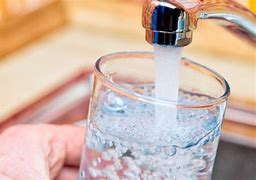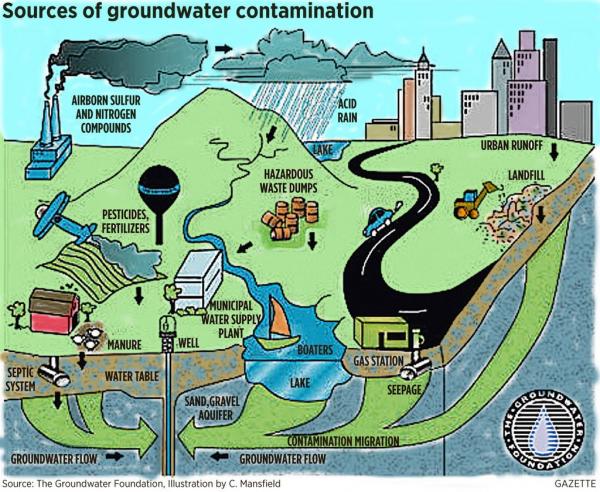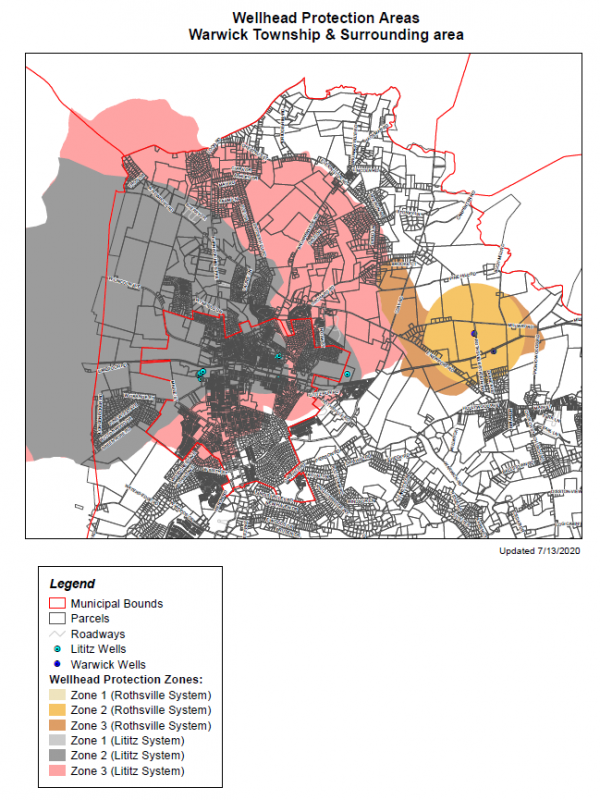Wellhead Protection Program
Lititz Area Wellhead Protection Program
 Clean, plentiful drinking water is often taken for granted. The rapid growth this area is experiencing threatens our public water supply through increased demand and potential contamination. Anyone can be involved in protecting this vulnerable resource. This article is to help you, the public, understand groundwater and its importance. It is also a guide to potential threats and individuals can do to protect the water they drink.
Clean, plentiful drinking water is often taken for granted. The rapid growth this area is experiencing threatens our public water supply through increased demand and potential contamination. Anyone can be involved in protecting this vulnerable resource. This article is to help you, the public, understand groundwater and its importance. It is also a guide to potential threats and individuals can do to protect the water they drink.
What is groundwater?
Groundwater is water beneath the earth's surface, often, between saturated soil and rock, that supplies wells and springs. Typically, this water is filtered and cleaned as it infiltrates the soil. The longer it takes the water to infiltrate the soil, the better it is filtered. The limestone geology of the area provides plentiful quantities of groundwater. However, the solution channels and sinkholes which characterize this geology allow contaminants to enter the groundwater system rapidly without the filtration needed to cleanse the water.
What is a wellhead protection area?
The recharge areas, or wellhead, for a water supply well are defined as that area which contributes groundwater to a well. When groundwater becomes contaminated, it may adversely impact drinking water supplies in the wellhead area. Protecting the wellhead area avoids the high cost of correcting a contaminated groundwater supply.
There are two wellhead protection areas within the Lititz Area Wellhead Protection Program. Lititz Borough's and much of Warwick Township's public water is supplied from groundwater sources accessed by six wells located within the Borough and one well located in Warwick Township. The Village of Rothsville is supplied with public water from two Warwick Township Municipal Authority (WTMA) wells located along or adjacent to Rothsville Station Road. Click here for a PDF version of the wellhead protection zone map illustrated below.
Threats & Potential Contaminants
The greatest potential threat to the Lititz Area and Rothsville Wellhead recharge areas is the contamination of groundwater. The following information outlines potential sources of water contamination along with recommendations for the prevention of contamination.

1. Sinkholes occur when subsurface limestone is weakened and collapses due to ponding of surface water or subsurface solution channels. Contaminants directly enter the groundwater system at these locations.
Prevention:
- Do not dump waste and debris in sinkholes
- Erect a fence or buffer around the edge to prevent access
- Divert drainage to keep water from running into the sinkhole
- Large ponds or basins should be lined to prevent sinkholes from developing
> Click here for additional information about sinkholes.
2. Spills and Leaks from accidents or damaged subsurface tanks or lines can discharge large amounts of contaminants directly into the groundwater system. In fact, it does not take long for toxic substances to travel long distances and contaminate a drinking water supply.
Prevention:
- Notify the fire or police department (dial 911) if you witness any spills or leaks
- Transport hazardous materials in certified containers
- Rapid response to a spill is critical
- Contact emergency response specialists immediately
3. Swimming Pool chemicals can be a source of groundwater contamination.
Prevention:
- Check for leaks and fix immediately
- Take care to prevent spills when adding chemicals
- Dispose of pool chemicals at approved centers
> Click here for more information about pool water discharge
4. Agricultural Practices are associated with cropland and streambank erosion along with nutrient pollution from over fertilizing.
Prevention:
- Promote nutrient management planning
- Stabilize and fence streambanks
- Redistribute manure countywide
5. Stormwater drains directly to our streams, and ultimately, to our watershed untreated. Contamination of the stormwater system leads to contamination of our streams and water supply. Clean water is everyone’s responsibility.
Prevention:
- Don’t dump or pour any material into storm drain inlets.
- Don’t pile or dump grass clippings, leaves, mulch or other debris in basins, swales or streams.
- Don’t apply pesticides, fertilizer or herbicides prior to or during a rainfall.
> Click here for more information about stormwater
6. Fertilizers and Pesticides are commonly used to control pests and encourage growth of landscape plantings. Consistent and heavy use of these substances can have adverse effects on groundwater.
Prevention:
- Follow manufacturer's instructions closely and do not apply more than the recommended amount
- Treat plants only when infected with pests or disease
- Reduce lawn areas, replace with native woodlands, hedgerows or meadows
- Limit applications to spring and fall
> Click here to view a list of native plant species for our region (scroll to "G")
7. Ground Source Heat Pump Systems (GSHP) are an increasingly popular energy source. These systems have the potential to cause groundwater problems if not properly installed or if they malfunction over time.
Prevention:
- Fix leaks or malfunctions immediately
- Take care to prevent surface to subsurface channels when constructing the well
- Monitor groundwater supplies and note any changes related to use of the GSHP
8. Hazardous Household Products should be disposed of in a responsible manner. These materials include auto products, cleansers, floor and furniture polish, gasoline, batteries, furniture stripping and refinishing materials, paints and photographic chemicals.
Prevention:
- Dispose of hazardous materials at approved centers, not in septic systems
- Fuel oil should be recycled or changed at a service station or repair shop
- Car washing should be done at a commercial car wash tied into a public sewer system
Dispose of household hazardous materials for FREE at the following location:
Lancaster County Solid Waste Management Authority
Household Hazardous Waste Facility
1299 Harrisburg Pike, Lancaster, PA 17603
Call 717-397-9968 for hours
 Taking responsibility for our impacts on water resources now, so that our children can grow up to live in a safe and healthy environment!
Taking responsibility for our impacts on water resources now, so that our children can grow up to live in a safe and healthy environment!


